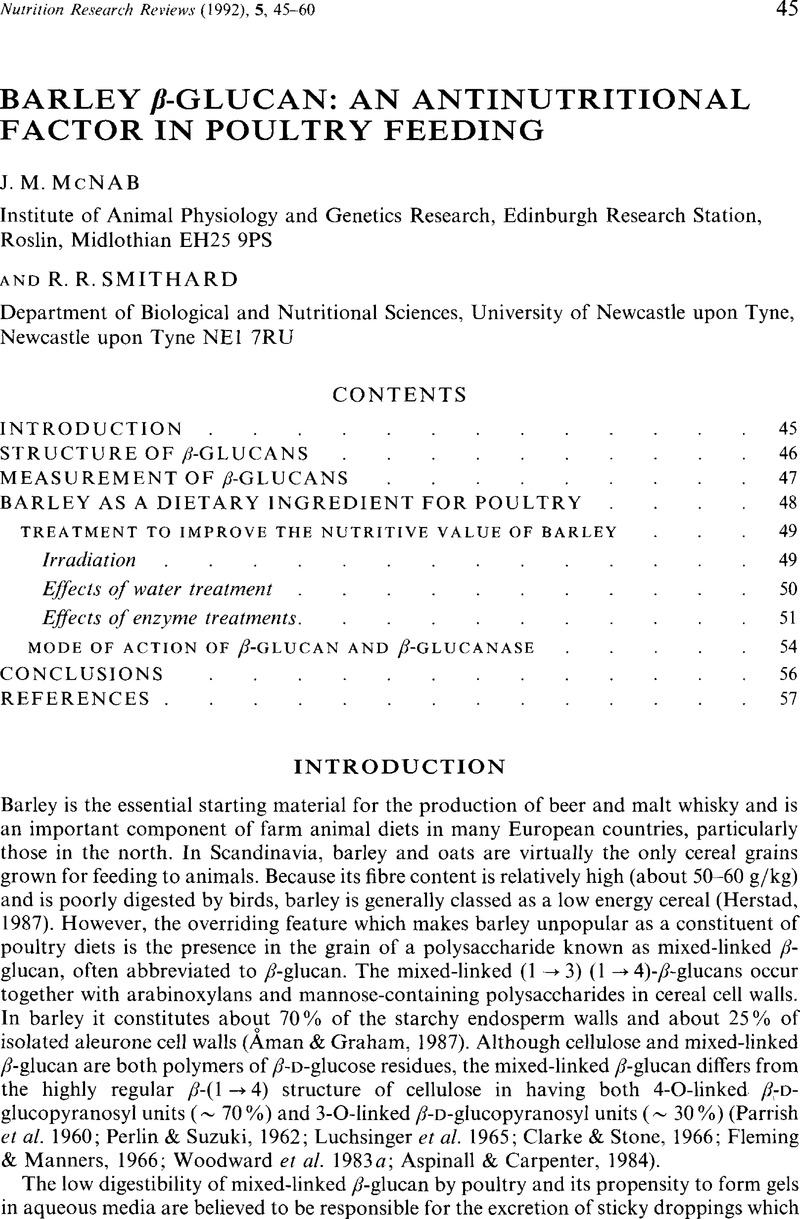Crossref Citations
This article has been cited by the following publications. This list is generated based on data provided by Crossref.
Jeroch, H.
and
Dänicke, S.
1995.
Barley in poultry feeding: a review.
World's Poultry Science Journal,
Vol. 51,
Issue. 3,
p.
271.
Pérez-Vendrell, A.M.
Guasch, J.
Francesch, M.
Molina-Cano, J.L.
and
Brufau, J.
1995.
Determination of β-(1–3), (1–4)-D-glucans in barley by reversed-phase high-performance liquid chromatography.
Journal of Chromatography A,
Vol. 718,
Issue. 2,
p.
291.
Fuente, J.M.
Pérez^de Ayala, P.
and
Villamide, M.J.
1995.
Effect of dietary enzyme on the metabolizable energy of diets with increasing levels of barley fed to broilers at different ages.
Animal Feed Science and Technology,
Vol. 56,
Issue. 1-2,
p.
45.
Bach Knudsen, K.E.
Steenfeldt, Sanna
Børsting, C.F.
and
Eggum, B.O.
1995.
The nutritive value of decorticated mill fractions of wheat. 1. Chemical composition of raw and enzyme treated fractions and balance experiments with rats.
Animal Feed Science and Technology,
Vol. 52,
Issue. 3-4,
p.
205.
Philip, J. S.
Gilbert, H. J.
and
Smithard, R. R.
1995.
Growth, viscosity and beta‐glucanase activity of intestinal fluid in broiler chickens fed on barley‐based diets with or without exogenous beta‐glucanase.
British Poultry Science,
Vol. 36,
Issue. 4,
p.
599.
Gdala, Jolanta
Johansen, Helle N.
Bach Knudsen, K.E.
Knap, Inge H.
Wagner, P.
and
Jørgensen, O.B.
1997.
The digestibility of carbohydrates, protein and fat in the small and large intestine of piglets fed non-supplemented and enzyme supplemented diets.
Animal Feed Science and Technology,
Vol. 65,
Issue. 1-4,
p.
15.
Castañón, J.I.R.
Flores, M.P.
and
Pettersson, D.
1997.
Mode of degradation of non-starch polysaccharides by feed enzyme preparations.
Animal Feed Science and Technology,
Vol. 68,
Issue. 3-4,
p.
361.
Givens, D. I.
De Boever, J. L.
and
Deaville, E. R.
1997.
The principles, practices and some future applications of near infrared spectroscopy for predicting the nutritive value of foods for animals and humans.
Nutrition Research Reviews,
Vol. 10,
Issue. 1,
p.
83.
Villamide, MJ
Fuente, JM
Perez de Ayala, P
and
Flores, A
1997.
Energy evaluation of eight barley cultivars for poultry: effect of dietary enzyme addition.
Poultry Science,
Vol. 76,
Issue. 6,
p.
834.
Fuente, J.M.
Perez de Ayala, P.
Flores, A.
and
Villamide, M.J.
1998.
Effect of storage time and dietary enzyme on the metabolizable energy and digesta viscosity of barley-based diets for poultry.
Poultry Science,
Vol. 77,
Issue. 1,
p.
90.
Fontes, Carlos M.G.A.
Ali, Simi
Gilbert, Harry J.
Hazlewood, Geoffrey P.
Hirst, Barry H.
and
Hall, Judith
1999.
Bacterial xylanase expression in mammalian cells and transgenic mice.
Journal of Biotechnology,
Vol. 72,
Issue. 1-2,
p.
95.
Bergh, M.O
Razdan, A
and
Åman, P
1999.
Nutritional influence of broiler chicken diets based on covered normal, waxy and high amylose barleys with or without enzyme supplementation.
Animal Feed Science and Technology,
Vol. 78,
Issue. 3-4,
p.
215.
YASAR, S.
1999.
Performance and gastro-intestinal response of broiler chickens fed on cereal grain-based foods soaked in water.
British Poultry Science,
Vol. 40,
Issue. 1,
p.
65.
Givens, D Ian
Davies, Tim W
and
Laverick, Richard M
2000.
Dietary fibre fractions in hulled and naked winter oat grain: effects of cultivar and various agronomic factors.
Journal of the Science of Food and Agriculture,
Vol. 80,
Issue. 4,
p.
491.
Yasar, S.
and
Forbes, J. M.
2000.
Enzyme supplementation of dry and wet wheat-based feeds for broiler chickens: performance and gut responses.
British Journal of Nutrition,
Vol. 84,
Issue. 3,
p.
297.
Al-Kaisey, Mahdi T
Mohammed, Mahmoud A
Alwan, Abdul-Kader H
and
Mohammed, Manal H
2002.
The effect of gamma irradiation on the viscosity of two barley cultivars for broiler chicks.
Radiation Physics and Chemistry,
Vol. 63,
Issue. 3-6,
p.
295.
Rampitsch, Christof
Ames, Nancy
Storsley, Joanne
and
Marien, Lindsay
2003.
Development of a Monoclonal Antibody-Based Enzyme-Linked Immunosorbent Assay To Quantify Soluble β-Glucans in Oats and Barley.
Journal of Agricultural and Food Chemistry,
Vol. 51,
Issue. 20,
p.
5882.
Moharrery, A.
2006.
Comparison of performance and digestibility characteristics of broilers fed diets containing treated hulled barley or hulless barley.
Czech Journal of Animal Science,
Vol. 51,
Issue. 3,
p.
122.
Fast Seefeldt, Helene
van den Berg, Frans
Köckenberger, Walter
Engelsen, Søren Balling
and
Wollenweber, Bernd
2007.
Water mobility in the endosperm of high beta-glucan barley mutants as studied by nuclear magnetic resonance imaging.
Magnetic Resonance Imaging,
Vol. 25,
Issue. 3,
p.
425.
Glatz, P. C.
Miao, Z. H.
Rodda, B. K.
and
Wyatt, S. C.
2008.
Effect of diets with different energy and protein levels on performance of grower ostriches.
Australian Journal of Experimental Agriculture,
Vol. 48,
Issue. 10,
p.
1338.





